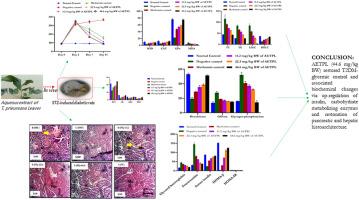Trichilia prieureana A. Juss 叶水提取物对果糖喂养链脲佐菌素诱导的雄性 Wistar 糖尿病大鼠的抗糖尿病活性
IF 3
3区 医学
Q1 INTEGRATIVE & COMPLEMENTARY MEDICINE
Journal of Traditional and Complementary Medicine
Pub Date : 2025-09-01
DOI:10.1016/j.jtcme.2024.07.006
引用次数: 0
摘要
背景和目的毛赤毛叶甲醇提取物具有抗高血糖作用,但对其抗糖尿病作用的研究尚无详细报道。本研究探讨了金针叶水提物(AETPL)对2型糖尿病(T2DM)雄性大鼠的抗糖尿病作用。实验方法:B、C、D、E、F组2 dm大鼠(随机给予10%果糖溶液诱导2周,外加链脲唑菌素[STZ]; 40 mg/kg体重{BW})分别给予AETPL蒸馏水(DW)、二甲双胍(100 mg/kg BW)、11.2、22.3和44.6 mg/kg BW,而A组非糖尿病大鼠仅给予DW (Sham Control, SC),持续14 D。然后评估t2dm相关参数。结果果糖饲链脲霉素(FSTZ)治疗组FBS、HbA1c、果糖胺、HOMA-IR、G6P、GP、TC、TG、LDL-C、尿素、胆红素、肝脏和胰腺MDA水平显著升高(p < 0.05);在大多数情况下,AETPL逆转了体重、血清胰岛素、肌酐、白蛋白、HOMA-β、糖原、G6PD、HK、HDL-C、肝脏和胰腺SOD、GPX、RG、过氧化氢酶、Hb、PCV、MCH、MCHC、MCV、RBC、WBC、差异和胰腺β细胞破坏、肝细胞变性、肝中央静脉充血的降低,其值与SC相比良好。在IpGGT模型中,腹腔注射AETPL降低血糖并升高血浆胰岛素水平。AETPL浓度为44.6 mg/kg BW时效果最显著。结论aetpl (44.6 mg/kg BW)通过上调胰岛素、碳水化合物代谢酶和恢复胰腺和肝脏组织结构,恢复t2dm -血糖控制及相关生化变化。本文章由计算机程序翻译,如有差异,请以英文原文为准。

Anti-diabetic activity of aqueous extract of Trichilia prieureana A. Juss leaves in fructose-fed streptozotocin-induced diabetic male Wistar rats
Background and aim
Ethanolic extract of Trichilia prieureana leaves have been reported to exhibit anti-hyperglycemic activities without detailed information on the anti-diabetic activities. This study investigated the anti-diabetic activity of aqueous extract of T. prieureana leaves (AETPL) in type 2 diabetic (T2DM) male rats.
Experimental procedure
T2DM rats (induced with 10 % fructose solution ad libitum for 2 weeks and streptozotocin [STZ]; 40 mg/kg body weight {BW}) in groups B, C, D, E, and F were also administered distilled water (DW), metformin (100 mg/kg BW), 11.2, 22.3, and 44.6 mg/kg BW of AETPL, respectively, whilst non-diabetic rats in Group A received DW only (Sham Control, SC) for 14 days. The T2DM-related parameters were then evaluated.
Results
The fructose-fed streptozotocin-(FSTZ) treatment related significant (p < 0.05) increases in FBS, HbA1c, fructosamine, HOMA-IR, G6P, GP, TC, TG, LDL-C, urea, bilirubin, hepatic and pancreatic MDA levels; decreases in BW, serum insulin, creatinine, albumin, HOMA-β, glycogen, G6PD, HK, HDL-C, hepatic and pancreatic SOD, GPX, RG, catalase, Hb, PCV, MCH, MCHC, MCV, RBC, WBC, differentials and the destruction of the pancreatic β-cells, hepatocyte degeneration, and central hepatic vein congestion were reversed by AETPL, to values that compared well with SC in most cases. In the IpGGT model, the intraperitoneally administered AETPL reduced the blood glucose and elevated the plasma insulin levels. The AETPL at 44.6 mg/kg BW exhibited the most pronounced effects.
Conclusion
AETPL (44.6 mg/kg BW) restored T2DM-glycemic control and associated biochemical changes via up-regulation of insulin, carbohydrate metabolizing enzymes and restoration of pancreatic and hepatic histoarchitecture.
求助全文
通过发布文献求助,成功后即可免费获取论文全文。
去求助
来源期刊

Journal of Traditional and Complementary Medicine
Medicine-Complementary and Alternative Medicine
CiteScore
9.30
自引率
6.70%
发文量
78
审稿时长
66 days
期刊介绍:
eJTCM is committed to publish research providing the biological and clinical grounds for using Traditional and Complementary Medical treatments as well as studies that demonstrate the pathophysiological and molecular/biochemical bases supporting the effectiveness of such treatments. Review articles are by invitation only.
eJTCM is receiving an increasing amount of submission, and we need to adopt more stringent criteria to select the articles that can be considered for peer review. Note that eJTCM is striving to increase the quality and medical relevance of the publications.
 求助内容:
求助内容: 应助结果提醒方式:
应助结果提醒方式:


